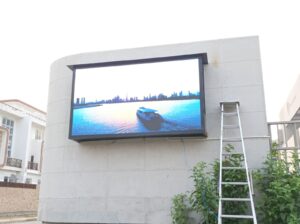Amidst the hustle and bustle of the city or the flurry of activity at the shopping center, your gaze is inevitably captured by the splendid LED video walls displaying irresistible ads and the most recent movie previews. These vibrant displays truly capture your attention and leave you in a state of wonder and curiosity.
At that moment, your mind races with questions: How is it possible for such a colossal display to produce such sharp and detailed images? How do they achieve such clarity and lifelike visuals that seem to jump out at you?
The answers lie in the hidden realm of pixel pitch.
The LED video wall is composed of many small dots. These dots, known as pixels, come together like a jigsaw puzzle to form mesmerizing images that captivate your senses. If you are a business owner looking to attract attention to your business with captivating LED video walls, but you are confused with pixel pitch, don’t worry we have got you covered.
In this blog, we will demystify pixel pitch, and its common categories, and discuss factors to keep in mind while selecting a good pixel pitch for the LED video wall.
What is pixel pitch?
Pixel pitch, typically measured in millimeters, refers to the distance between each LED pixel. It can significantly impact the quality of images and videos displayed on the screen. The image quality on a video wall is greatly improved with a smaller pixel pitch, as the clusters of small LEDs are placed closer together, resulting in greater clarity and sharper images or videos.
Pixel pitch should not be mistaken for resolution or pixel size. While resolution and pixel size are related to pixel pitch, it is important to note that they represent different aspects of the display. Let’s understand the basic differences between them:
Pixel Pitch vs. Resolution:
Pixel pitch and resolution are related but different concepts. Resolution is the number of pixels in a display and is shown by its width and height (like 1920×1080 pixels for Full HD). On the other hand, the pixel pitch refers to the actual distance between LEDs.
A smaller pixel pitch means more pixels in the same area, giving better resolution and image clarity. Pixel pitch alone does not determine the resolution. The determination is based on the combination of the display size and the pixel pitch.
| Pixel pitch | Resolution |
What are some common pixel pitch categories?
There are generally three common categories of pixel pitch in LED video walls:
Fine Pixel Pitch (Small pixel pitch):
- Fine pixel pitch displays are LED video walls that have small gaps between pixels, usually varying from 1.2 mm to 2.5 mm.
- These displays provide exceptional detail and clarity, making them ideal for close-up applications.
- A fine pixel pitch display offers vibrant colors, high contrast ratios, and smooth image rendering.
- These screens are great for indoor environments such as control rooms, boardrooms, retail stores, and museums, where audiences can view the content more closely.
Standard Pixel Pitch:
- Standard pixel pitch displays range from 2.5 mm to 4.0 mm and offer good image quality at an affordable price.
- This LED video wall has a good resolution and is suitable for indoor applications. In conference rooms, retail stores, airports, and hotels.
- Their clear visuals communicate information or advertising content effectively to viewers at moderate distances.
- These are popular for businesses that need impactful displays without high pixel density.
Coarse Pixel Pitch (Large pixel pitch):
- Displays with coarse pixel pitches typically have larger pixel distances, ranging from 4.8 mm to 10 mm.
- These LED screens are intended for viewing from a considerable distance by viewers. They are suitable for outdoor environments, stadiums, concert venues, and large public areas due to their cost-effectiveness and high brightness.
- Visuals are clear even at a distance, regardless of light or angle.
- Coarse pixel pitch LED video walls are durable, energy-efficient, and cost-effective, making them a great solution where high pixel density is not necessary.
What is a good pixel pitch?
To decide what is a good pixel pitch, there are some factors to keep in mind. A good pixel pitch depends on the business’s needs and requirements and may involve some trade-offs. Therefore, it’s imperative to pay close attention to the pixel pitch to ensure you make the right purchasing decision. Here are some factors to consider:
- Viewing distance: The optimal pixel density of a display depends on the distance from which it will be viewed. In large venues like stadiums or conferences, a higher pixel pitch can be used since people won’t be able to see the individual pixels from far away. In some situations, like in stores or control rooms, it is important to have a smaller pixel pitch to ensure that the images are clear and sharp.
A big factor in deciding pixel pitch is also whether you want an indoor video wall or an outdoor video wall. Typically, Fine pixel pitch or standard pixel pitch is more suited for indoors, while coarse pixel pitch is more suitable for outdoors.
- Content type: Consider the nature of the content that will be displayed on the LED video wall. To display high-quality videos with intricate graphics and detailed visuals, a small pixel pitch is necessary to ensure precise representation and prevent pixelation. A larger pixel pitch could be sufficient for displaying simple texts or basic graphics.
Related: Check out our expert tips for video wall content creation. - Desired image quality: Selecting the optimal image quality is crucial when installing LED video displays, particularly concerning their location, whether indoor or outdoor. The image quality depends on the pixel density; increasing the pixel density by opting for smaller pixel pitches leads to more intricate and clearer visuals. Choose a smaller pixel pitch for clear images with details, especially if you want high-resolution content for indoor displays. Outdoor LED displays can have a lower pixel density without compromising on quality.
It’s important to keep in mind that having a very small pixel pitch may not always make a noticeable difference, especially if the viewing distance is far or the content lacks fine details. - Budget and cost considerations: The LED video wall cost is directly influenced by the pixel pitch. Reducing the size of pixel pitch leads to an increased need for LEDs and components, thus escalating the cost. It is crucial to strike a balance between the quality of the image you desire and the limitations of your budget.
- Installation environment: Take into account the installation environment of the LED video wall. To make an informed decision on pixel pitch, it is vital to consider various factors, including ambient lighting, viewing angles, and physical constraints at the installation location. In areas with high ambient light, a smaller pixel pitch can improve visibility.
- Trade-offs and considerations: Although reducing the pixel pitch often results in better image quality, it’s important to take some trade-offs into account. If the pixel pitch is too small, the viewer may not be able to perceive the additional details because of the constraints of human sight or the presented content, ultimately resulting in decreased benefits.
Additionally, reducing the pixel pitch increases the display’s energy consumption. To set off such trade-offs, contact our experts who will help you get the most appropriate pixel pitch-led video wall displays for your business.
Conclusion
Selecting the right pixel pitch for your LED video wall is crucial to achieving the desired image quality and staying within budget. Consider factors such as viewing distance, content type, desired image quality, installation environment, and trade-offs when making this decision. Seek advice from Infonics experts on LED video walls to provide customized recommendations based on your needs.
Remember that pixel pitch alone does not determine resolution; it is determined by a combination of pixel pitch and display size.
By considering these factors and seeking professional guidance, you can ensure that you make an informed decision about which pixel pitch is best suited for your LED video wall requirements.





